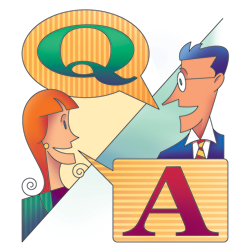|
REGISTRATION REQUIRED
exhibitor q&a
Help!
Graphics errors
 Q.
Our graphics need a complete overhaul, as they're basically an ineffective, jumbled mess. However, I'm not 100-percent sure where they went wrong in the first place. How do I create new booth graphics without making the same mistakes again?
A.
Many exhibitors are in the same boat. They know their graphics aren't serving them well, yet they can't quite put their finger on where they've gone dreadfully wrong. To help ensure your next set of graphics don't end up looking like the first, here are some of the most common errors exhibitors make when it comes to graphic design and production. ➤ Creating an oversized brochure. The biggest exhibit-graphic mistake is trying to turn a pamphlet into a graphic panel. Far too often exhibitors take a perfectly good image and cover it with paragraphs of text. However, attendees don't stop to read text-heavy graphics; in fact, this type of visual clutter often prevents them from stopping at all. Instead, graphics should communicate an idea, a message, or maybe a couple of key points in a clear, concise manner. In 10 seconds or less, they should explain what problem your product or service solves and what makes it unique. If you must provide additional details, do so in your collateral literature. ➤ Stretching resolution. Many exhibitors try to "make do" with low-cost, low-resolution images, and they end up with washed out or blurry graphics. Spending a little extra money to secure high-resolution stock images or pro-fessional photography will make a huge difference in graphic quality. ➤ Failing to factor in exhibitry. Typically exhibitors view and approve graphic files as standalone elements. Instead, always ask designers to render your graphics into an electronic version of the entire exhibit display. This way, you'll have a much better idea of whether their size and positioning will make the impression you intended. For example, exhibit components, shelves, monitors, etc. can obstruct the view of key graphics. Or perhaps that 8-foot panel you created is getting lost in your 50-by-50-foot exhibit. Seeing the graphics rendered into the design will provide the perspective you need to know how your graphics will actually look in the space. ➤ Designing in a vacuum. Like a clothing line at New York Fashion Week, your exhibit graphics should tell a cohesive story, as opposed to functioning as independent elements without connection. For example, you might have four product-centric panels at ground level, two large billboard graphics above your booth, and maybe eight kiosk-based panels. While they may serve different purposes, they must all communicate in a similar fashion and have something to visually and mentally link them to one another. This connection could be created via images, colors, messaging, positioning, scale, etc. But without a link, your graphics will fail to work together and will instead confuse your message – and attendees. ➤ Indulging a font fetish. One or two fonts are plenty. I promise. Any more than that, and you've got an identity crisis on your hands. That's because legibility is key with any graphic design, but it's especially critical with graphics viewed from a distance. As such, you want to use familiar, highly legible fonts to create a clean, consistent look, which will ultimately enable attendees to quickly consume your messages. And as a general rule, opt for common fonts, such as Helvetica or Garamond, and avoid ornamental fonts like Peace Mustache and Sweet Cheeks. (Yes, these actually exist.) ➤ Thinking small. Once in a while you need a graphic to accompany a kiosk or a tiny product display. But more often than not, the purpose of your graphics is to lure in attendees and communicate a single message about your company, products, or brand. As such, you're better off with a few large graphics than with crates full of small graphics meant to be viewed from 2 feet away. If you need to communicate at a 2-foot distance, poster board, iPad imagery, or printed literature usually provides a better bang for your buck. ➤ Forgoing professionals. You can destroy your exhibit's aesthetic quality in a heartbeat if you fill your space with lackluster, unprofessional graphics. So always hire a professional graphic designer with experience in trade show work. He or she should know how to obtain quality files, format them, design your graphics, and hit your deadlines with ease. If you don't know how to create raster versus vector files, you can't expound upon the nuances of continuous tone, and you think a graphic bleed sounds like a bloody mess, your role in the graphic-design process should merely be to approve or disapprove of finished, professional designs. While these missteps are just the tip of the iceberg, they're among the most common mistakes exhibitors make when it comes to graphic design and production. By simply avoiding these pitfalls, you're far more likely to create an effective and eye-catching graphic system for your next exhibit. — Mel White, vice president of marketing and business development, Classic Exhibits Inc., Portland, OR
Help Wanted Send your tough questions about exhibiting to Linda Armstrong, larmstrong@exhibitormagazine.com.
|
|
|
||||||||||||||||||||||||||||
|
|
||||||||||||||||||||||||||||
|
TOPICS Measurement & Budgeting Planning & Execution Marketing & Promotion Events & Venues Personal & Career Exhibits & Experiences International Exhibiting Resources for Rookies Research & Resources |
MAGAZINE Subscribe Today! Renew Subscription Update Address Digital Downloads Newsletters Advertise |
FIND IT Exhibit Producers Products & Services All Companies Get Listed |
EXHIBITORLIVE Sessions Exhibit Hall Exhibit at the Show Registration |
ETRAK Sessions Certification F.A.Q. Registration |
EDUCATION WEEK Overview Sessions Hotel Registration |
CERTIFICATION The Program Steps to Certification Faculty and Staff Enroll in CTSM Submit Quiz Answers My CTSM |
AWARDS Exhibit Design Awards Portable/Modular Awards Corporate Event Awards Centers of Excellence |
NEWS Associations/Press Awards Company News International New Products People Shows & Events Venues & Destinations EXHIBITOR News |
||||||||||||||||||||
|
||||||||||||||||||||||||||||






